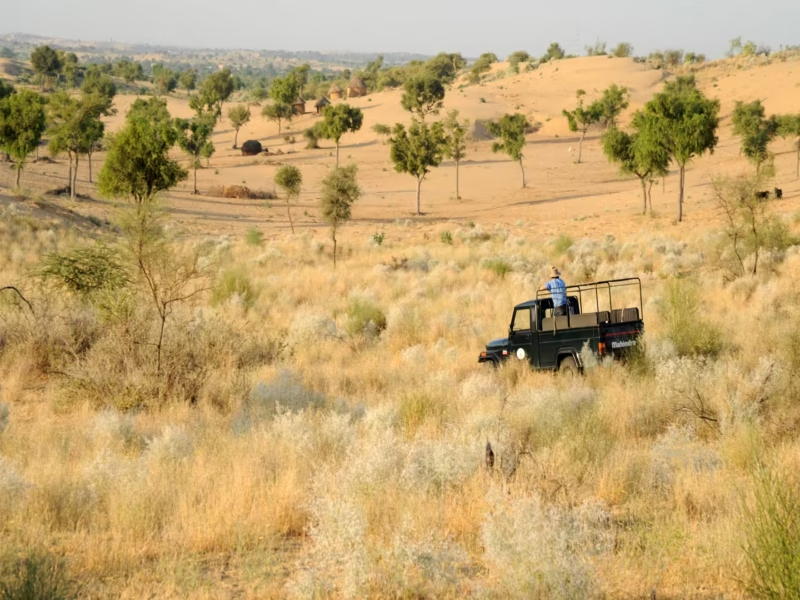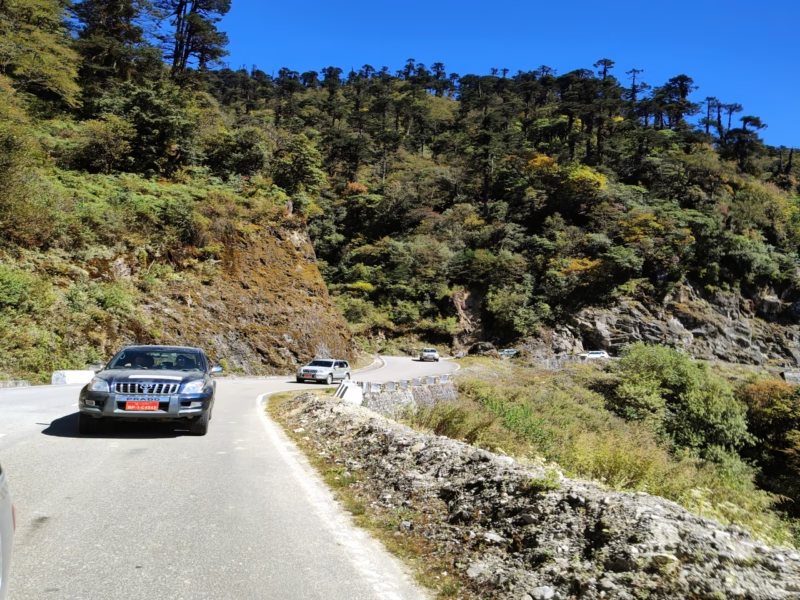Day 1 | Arrival in Paro (185 kilometers / 115 miles)
*Altitude: 2,250 meters
Planet Way Round representative will meet you at Paro International Airport in Bhutan. You will be transported to the hotel. Take rest and meet your fellow members at the dinner table.
Day 2 | Hike to Taktsang (Tiger Nest) Monastery in Paro (900 meters above Paro Valley)
After driving for around 35 minutes, the Taktsang hike (also famously called as “Tiger Nest”) will begin early in the morning as it will be cool. You will begin the hike at the Taktsang base where a shopkeeper and horseman can be found. Your walk will be through a forest for almost one hour and 30 minutes, and soon, you will reach Takstang cafeteria. Sip some tea while enjoying a very spectacular view of Taktsang Monastery.
After visiting Taktsang Monastery, you will return to the cafeteria to have lunch and walk down to the base and drive towards Paro to visit Drukgyal Dzong, although it is now mostly in ruins and under construction. You will stay overnight at Hotel Olathang or similar accommodations.
Day 3 | Paro – Chelele La Pass – Thimphu (218 kilometers / 136 miles)
*Altitude: Chelele La Pass: 3,988 meters; Thimpu: 2,320 meters
Chelele La is located between Haa and Paro which is 50 kilometers away from Paro Valley. It is the highest motorable pass in Bhutan situated at 3,988 meters or 13,084 feet. From there, you can view some of the highest and unclimbed beautiful Himalayan mountain passes on a clear day.
On reaching the pass, you could see prayers flags fluttering wildly in the breeze and chilly wind. Some of the snow-capped mountains can be viewed from there during the summer too. After riding around 30 minutes, you will have lunch at Haa Valley. You will proceed towards Thimphu. You will stay overnight at Hotel Phuntsho Pelri or similar accommodations.
Day 4 | Thimphu – Punakha (142 kilometers / 89 miles)
*Altitude: 1,310 meters
Taking some leisure time in Dochula to check the views of the Eastern Himalayas, you will have coffee or tea or otherwise lunch at Dochula Cafeteria. After that, your journey towards Punakha starts. The road is 100 percent tarmac and double lane. Before reaching Punakha, you may visit Chimi Lhakhang and Punakha Dzong if you wish.
You may also take a trip to the longest suspension bridge and enjoy the views if you want. You will stay overnight at Zhingkham Resort or similar accommodations. From there, you can have an aerial view of Punakha Valley.
Day 5 | Punakha to Phobjikha (77 kilometers / 48 miles)
*Altitude: more than 3,000 meters
After breakfast, your journey begins from Punakha to Wangdue. It will be the same temperature as Punakha. As you approach Phobjikha Valley through a forest of oak and rhododendron, it will be colder. The road will be mostly blacktopped but in some places, road widening is still on-going but soon, it will be a double lane with tarmac.
You will have lunch at Nobding, a small town located in between Wangdue and Phobjikha. Upon reaching Phobjikha, you will visit Gangtey Goenpa, the Black-Necked Crane Information Center, and Phobjikha Valley. You will stay overnight at Hotel Dewachen, a farmhouse, or homestay.
Day 6 | Gangtey, Phobjikha
After a leisurely breakfast at the hotel, you begin today’s tour with an excursion to Tangjey Lhakhang (3,050-meter distance, 10 to 12-kilometer duration, 4 to 5 hours). You set out on a day’s hike toward the southeast direction through a vegetation of dwarf bamboos that adorns the Phobjikha Valley. This valley is where the rare black-necked cranes reside during the winter season, beginning November until mid-March.
After an hour of an easy hike, you reach the small settlement of Kilkhorthang village. You take a short rest to enjoy the dramatic landscape of the valley before continuing towards Tangjey, passing through vegetable fields and orchards. Tangjey Lhakhang (temple) is dedicated to Lord Buddha and its local protective deity Yeshi Gempo. The original foundation of the temple dates back to 1517-1554. After an enjoyable visit to the temple, you head back to the hotel crossing a wooden bridge over a crystal clear river. Your day can be ended, if you wish, with a little celebration of locally distilled traditional drink.
Day 7 | Gangtey – Trongsa – Bhumthang (220 kilometers / 137 miles)
*Altitude: 2800 meters
After breakfast, you take a short nature walk in the vicinity of the hotel and then after, you drive to Bumthang, crossing Pele La pass (3,300 meters / 10,830 feet) via Trongsa. Pela La is marked by a large white chorten with prayer flags. There is an abrupt change in vegetation at this point where the mountain forest trees are replaced by high altitude dwarf bamboos. You stop, en route, at Chendebji Chorten which is patterned on the Kathmandu’s Swayambhunath Stupa, with eyes painted at four cardinal points. It was built in the 18th century by Lama Shida from Tibet. The stupa’s purpose was to cover the remains of an evil spirit that was subdued at this spot.
Also, en route to Bumthang, you visit Trongsa Dzong. The fort was built in 1648 and it was the seat of power over central and eastern Bhutan at that time. Both the first and second kings of Bhutan ruled the country from this ancient dzong. All four kings were invested as Trongsa Penlop (‘governor’) prior to ascending the throne and the present crown prince now holds the post. The dzong is a massive structure with many floor levels, sloping down the contours of the ridge on which it was built.
You will also visit Ta Dzong, a cylindrical stone watchtower rising five stories. It was built in 1652 by Chogyal Minjur Tempa. After more than 350 years, it has been resurrected to become an impressive museum that represents a tasteful blend of tradition and modernity. The Ta Dzong is the only structure in the entire country that has been restored specifically to tribute the Wangchuck dynasty as Bhutan celebrates the centenary of the monarchy. Further 68-kilometer drive across the Yutong La pass (3,400 meters / 11,155 feet) will finally bring you to the wide open cultivated Bumthang Valley.
Day 8 | Bhumthang
*Altitude: 2,800 meters
After breakfast, you proceed on your tour of the Bumthang Valley. Bumthang is the general name given to the combination of four valleys (Chumey, Choekhor, Tang, and Ura with altitude varying from 2,600 to 4,000 meters). There are many prominent Buddhist temples and monasteries in the Bumthang valleys. You will also visit Kurjey Lhakhang. It is a temple where the saint Padmasambhava (Guru Rinpoche) subdued a local demon and left his body imprint on a rock.
You will then visit the Jambey Lhakhang (a 7th-century temple), Tamshing Lhakhang (a temple that holds some of the oldest wall paintings in Bhutan), and Jakar Dzong (an administrative center of the region). You then stroll in a village, visiting a little handicraft shop at the entrance to the town and perhaps stopping to take refreshments at a local restaurant. Later in the afternoon, if time permits, you visit Wangdicholing Palace (visitors allowed from outside only).
Day 9 | Bumthang to Trongsa (80 kilometers / 50 miles)
*Altitude: 2,200 meters
%You will travel to most extensive protected areas network in Bhutan. The northern two-thirds of the district, the gewogs of Chhoekhor and Tang, belong to Wangchuck Centennial Park, buffered by pockets of biological corridors. Southern Bumthang, the gewogs of Chhumig, Tang, and Ura, is part of another protected area, Thrumshingla National Park. Bumthang is known for its important population of black-necked cranes migrating in the winter.
You will have lunch at Trongsa Town and visit the zong. You will stay overnight at hotel.
Day 10 | Trongsa – Gelephu (275 kilometers / 171 miles)
*Altitude: 600 meters
Today, you will visit the city of Trongsa located on a steep ridge from where you will enjoy spectacular views of the deep valleys that surround the city. You will have with a lesson of the history of the kingdom at the Watchtower of Trongsa that has been converted into a museum dedicated to the Wangchuck dynasty. Then, you will visit Trongsa Dzong, the largest dzong fortress in Bhutan, which is visible from anywhere in the town. You will continue riding until you reach Gelephu. Here, you will spend a relaxing night.
Day 11 | Gelephu – Lobesa (185 kilometers / 115 miles)
*Altitude: 1350 meters
This day is dedicated to discovering the beautiful region of Gelephu located in Southern Bhutan on the border with India. Gelephu is a warm, fertile region with plenty of rainfall. The region is also the gateway to the Royal Manas National Park, the oldest nature preserve in the Kingdom of Bhutan. Its incredible biodiversity includes hundreds of rare animal and plant species that cannot be seen anywhere else in the world such as golden langurs, Gangetic dolphins, and the Asian one-horned rhinoceros. You will end this great day in Lobesa.
Day 12 | Lobesa – Paro (140 kilometers / 87 miles)
*Altitude: 820 meters
After breakfast, you will ride two amazing places. You’ll enjoy a pleasant ride till Paro, the final stop of the day. Here, you will have dinner and spend the night.
Day 13 | Departure
This is the end of the tour, you will be dropped off at the airport.

 Review
Review














